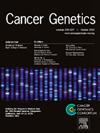复发性细胞遗传学异常揭示了促进骨髓增生异常综合征进展和转化的改变
IF 1.4
4区 医学
Q4 GENETICS & HEREDITY
引用次数: 0
摘要
方法 在这项研究中,我们评估了三个不同的数据集,以确定复发性细胞遗传学异常(RCA),从而描述细胞遗传学的演变轨迹及其临床意义。结果 数据集 1 和 2 是来自 Mitelman 癌症染色体畸变和基因融合数据库的 2402 份横断面样本;这些样本用于发现 RCA 并对其进行验证。数据集 3 是由 163 名住院患者组成的队列,其中 35% 的患者有序列样本。该数据集用于进一步验证横断面数据中发现的 RCA 及其临床影响。我们发现了与 MDS 亚型相关的 RCA,以及一些导致疾病进展或转化为白血病的专属 RCA(Xp-、2q-、17q-、21q-)。进化途径分析表明,RCAs 的获得具有时间性。因此,两个或多个 RCA 的存在表明,它们在疾病进展或转化过程中起着合作或互补的作用。有一个或多个 RCAs 的患者预后较差,发生转化的风险较高。在 MDS 中经常发生改变的基因被映射到一些 RCA 上,这表明 RCA 与 MDS 的分子改变密切相关。该研究发现了RCA的独特组合,它们是不同细胞遗传学轨迹的组成部分。其中一些是原发性变化,而另一些则是继发性或三级变化。获得特定的额外畸变可预测白血病的进展或转化。本文章由计算机程序翻译,如有差异,请以英文原文为准。
Recurrent cytogenetic abnormalities reveal alterations that promote progression and transformation in myelodysplastic syndrome
Objective
To illustrate patterns of cytogenetic abnormalities that promote progression and/or transformation in myelodysplastic syndrome.
Methods
In this study we evaluated three different data sets to identify recurrent cytogenetic abnormalities (RCAs) to delineate the cytogenetic evolutionary trajectories and their clinical significance.
Results
Datasets 1 and 2 were 2402 cross sectional samples from Mitelman database of Chromosome Aberrations and Gene Fusions in Cancer; these were used to discover RCAs and to validate them. Dataset 3 was a cohort of 163 institutional patients with serial samples from 35 % of them. This was used to further validate RCAs identified in the cross-sectional data, and their clinical impact. We identified MDS subtype associated RCAs, and some exclusive RCAs (Xp-, 2q-, 17q-, 21q-) that led to disease progression or transformation to leukemia. Evolutionary pathway analysis had shown temporal acquisition of RCAs. Therefore, presence of two or more RCAs suggests cooperative or complementary role in disease progression or transformation. Patients with one or more of these RCAs had poor prognosis and high risk for transformation. Genes frequently altered in MDS are mapped to some of the RCAs and suggest a close correlation between RCAs and molecular alterations in MDS. Karyotypic complexity, clonal evolution, loss of 17p had poor clinical outcomes.
Conclusion
This study identified a unique combination of RCAs that are components in distinct cytogenetic trajectories. Some of these were primary changes while others were secondary or tertiary changes. Acquiring specific additional aberrations predicts progression or transformation to leukemia.
求助全文
通过发布文献求助,成功后即可免费获取论文全文。
去求助
来源期刊

Cancer Genetics
ONCOLOGY-GENETICS & HEREDITY
CiteScore
3.20
自引率
5.30%
发文量
167
审稿时长
27 days
期刊介绍:
The aim of Cancer Genetics is to publish high quality scientific papers on the cellular, genetic and molecular aspects of cancer, including cancer predisposition and clinical diagnostic applications. Specific areas of interest include descriptions of new chromosomal, molecular or epigenetic alterations in benign and malignant diseases; novel laboratory approaches for identification and characterization of chromosomal rearrangements or genomic alterations in cancer cells; correlation of genetic changes with pathology and clinical presentation; and the molecular genetics of cancer predisposition. To reach a basic science and clinical multidisciplinary audience, we welcome original full-length articles, reviews, meeting summaries, brief reports, and letters to the editor.
 求助内容:
求助内容: 应助结果提醒方式:
应助结果提醒方式:


